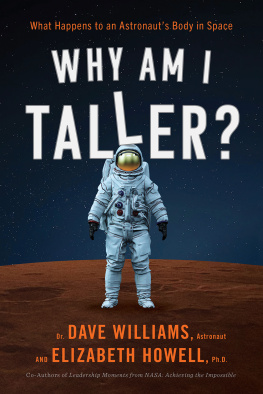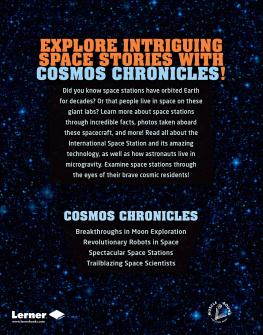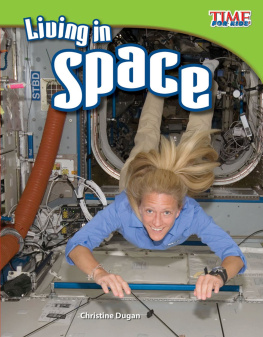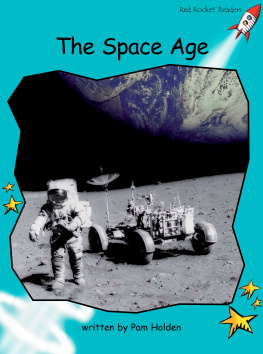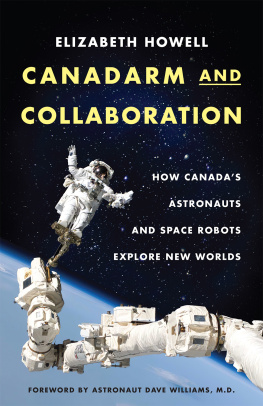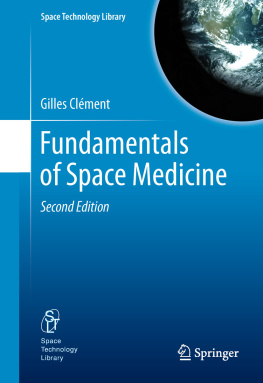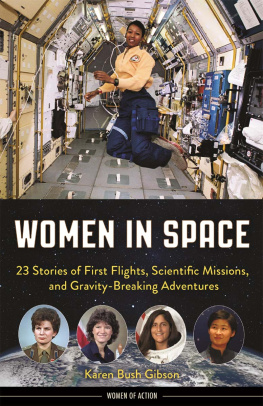In memory of Charles A. Berry, MD The Astronauts Doctor
Preface
Earth is the cradle of humanity, but one cannot live in a cradle forever.
Konstantin Tsiolkovsky
As the golden rays of the slowly setting sun emerge over the horizon, the hint of darkness grows. The twinkling bright light of Venus that has captured the imagination of stargazers throughout history appears in the ever-deepening dark blue above. Commonly referred to as the evening star, it is the prelude to the wonder of the night sky and the many constellations that fascinate us, just as they did the early astronomers. In far northern or southern regions, some may be lucky enough to see the magic of the aurora dancing in the heavens. This spectacular ever-changing vista of lights was thought by some ancient societies to represent the forces of good and evil dragons, their fire battling on high. Others felt that the shifting curtain of lights represented lost loved ones trying to communicate with friends and relatives back on Earth. The sense of awe and wonder invoked by the darkness above has touched onlookers spirits for millennia, a reminder of the fragility of our shared human existence in the vast infinite void of space. Throughout history, looking up at the night sky has inspired deep curiosity about what may be out there. Those feelings were a major force that indelibly shaped my future.
Growing up in what was one of the most remarkable decades of exploration in history, I was a typical child of the 60s. Virtually every waking hour was spent outdoors, especially in the summertime. My earliest recollections go back to when I was five or six years old, when my friends and I would lie on our backs enveloped by the smell of fresh grass and gaze upward, mesmerized by the stars above, challenging each other to identify the few constellations we knew. These were the early days of space exploration and there were few human-made satellites to be seen. When we spotted them as small, moving, faint lights, our imagination immediately made us wonder if they were UFOs, alien spacecraft coming to visit our planet a popular topic of comic books at that time. Little did I realize then that my childhood dreams of exploring space and the undersea world would one day come true.
Given what appeared to be an impossible path to become an astronaut, exploring the oceans seemed a more achievable goal and I was fortunate to learn to scuba dive when I was 12. The Undersea World of Jacques Cousteau was a popular TV series at the time and every week I vicariously participated in the exploits of Cousteaus team aboard the Calypso. Over time, my passion for diving grew into a broader desire to understand how the human body adapted to living underwater in undersea habitats. Similarly, my interest in spaceflight, inspired by the NASA missions of the Mercury, Gemini and Apollo astronauts, made me wonder about the remarkable ability of humans to thrive in such different worlds the frontiers of space and the ocean. That quest for knowledge took me to McGill University on a 12-year journey that included studying comparative physiology and neuroscience, as an undergraduate and in graduate school, then going on to medical school.
When I responded to the Canadian Space Agencys call in 1992 for applicants to the second group of astronauts to be hired in Canada, I was working as Director of the Department of Emergency Services at Sunnybrook Regional Health Centre in Toronto. Emergency medicine specialty training had become recognized throughout North America in the preceding decade, and I was proud to have finished residency training in family medicine and specialty training in emergency medicine and then join a team of experienced clinicians able to deal with any medical or surgical emergency. Many of my colleagues and I were trauma team leaders. As well, our group provided the base hospital support for land paramedics and air ambulance attendants transporting critically ill patients. There was very little I had not seen in that role, at least on Earth. The experience was invaluable in becoming a physician astronaut (or astronaut physician the perspective varies but with the goal of furthering the field of space medicine I tend to use physician astronaut).
In the first 60 years of human spaceflight fewer than 600 people have travelled to space, roughly the number of people that might live in a small village. They have spent 161 person-years living and working in low Earth orbit and on the lunar surface, testing the limits of human performance in exploring the extreme, harsh environment of space. Less than 50 of those astronauts have been physicians and I felt fortunate to become part of that group. Despite the great honor, and the excitement I felt, it wouldnt be long before I was asking myself, Why is space so hard?
Physicians on Earth are trained to prevent illness and understand the pathophysiology of disease, how the normal functioning of the body becomes altered by disease. Such an understanding is critical to determine the best approach to managing illness or injury and was a fundamental part of my many clinical responsibilities in the emergency department. The prefix patho is derived from the Greek pathos , meaning suffering or disease, and reflects a disruption of the normal physiology or functioning of the body in which generally one organ system is affected by disease. Space medicine clinicians quickly understood that the normal functioning of the body is different during spaceflight. The physiological responses or adaptations observed in astronauts are widespread, including changes in cardiovascular conditioning, muscle strength, bone density, orientation and balance. With longer stays aboard the International Space Station, more health effects are being observed and while these changes reflect how quickly the body adapts to the microgravity of space, many are maladaptive from the perspective of living in a gravitational world whether on Earth or another planet. What happens to the human body in space can adversely affect the health and functioning of astronauts while there, and when they once again experience the effects of gravity.

